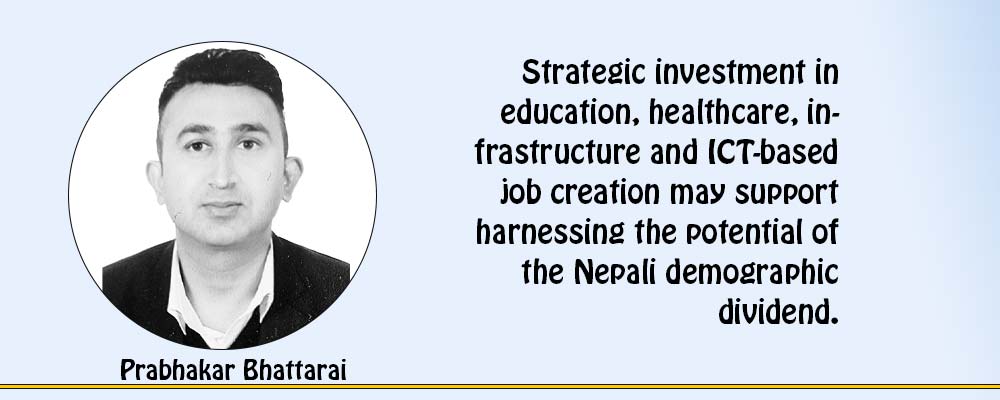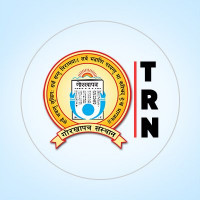- Thursday, 11 September 2025
Pathways To Harness Demographic Dividend
Nepali students have long been moving abroad in search of better education, career opportunities, and a quality of life. Many studies illustrate the fact that Nepal has emerged as one of the highest senders of international students in the world. The PIE (International Education News, Events and Recruitment for the Global Network) states that Nepal emerged as the United Kingdom's sixth largest source of students in the year ending June 2024, rising by 63 per cent over the previous year, despite an overall decline in visas issued to international students in the same period.
Immigration, Refugee and Citizenship Canada (IRCC) states that nearly 16,000 Nepali students were issued Canadian student visas for post-secondary studies in 2023. In sharp contrast, the number of Canadian student visas issued for Nepali students was just 370 in 2018. The case is no different in the United States of America. As per the statistics published by the US Department of State, 9200 Nepalese students were issued student visas from October 2023 to June 2024. This was an increase of 61 per cent over the full year 2023 and 49 per cent more than the full year 2023. These data represent the general tendency of Nepali students' enrollment in several international education destinations at present context.
Demographic dividend
According to statistics from the Ministry of Education, Science and Technology (MoEST) of Nepal and Nepal Rastra Bank (NRB), a total of 5,43,833 Nepali students in the age group 15-64 years received a No Objection Letter (NOC) for foreign study between the Fiscal Year 2018/19 and mid-March 2024/25. Demographic studies illustrate the population of the age group of 15-64 years as an active age group, and it determines the demographic dividend of the nation. National Population and Housing Census, 2021 (Demographic Dividend in Nepal) published by National Statistics Office of Nepal defines demographic dividend as: The economic growth potential that can result from shifts in a population's age structure, mainly when the share of the working-age population (15-64) is larger than the non-working age population (14 years of age and younger and 65 years of age and older).
As per the National Population and Household Census 2021, the share of the working-age (15-64 years) population constitutes 65.2 per cent of Nepal's total population. This figure fulfills the United Nations criteria for Nepal to have been entered into the demographic window of opportunity, which is generally termed as demographic dividend. The same report provides the idea that Nepal entered the stage of demographic dividend in 2017 and may continue to remain in the stage beyond 2051. Scholars suggest that the population aged 15-64 years should be highly mobilised for the economic growth of Nepal by 2051.
Demographic statistics stated above clearly indicate that Nepal is undergoing a significant demographic transition, resulting in the potential for a demographic dividend that could shape the country's economic landscape. However, the scenario of availability of quality human resources is very disappointing because the number of brain drains is increasing. This situation of an increasing number of Nepali students moving abroad for further study is leading to talent shortage in the most significant aspects of development, including education, health care, technology advancement and many others.
A large number of students studying abroad have a tendency to never return to their home country, which results in a major loss of competitive human resources. As a result, the Nepali economy lacks trained personnel, particularly in high-value sectors that are essential for the advancement of technology and industrial growth. An article published in mixedmigration.org suggests that, unless the fuller benefits of the demographic dividend are harnessed domestically, the rising population, especially of those of working age and younger, could be problematic in some countries.
The National Population Policy 2015 is the most recent comprehensive framework addressing population issues in Nepal. Acknowledging the significant youth population during the demographic dividend period, it emphasises the need to improve access to quality education and skill development, promote youth employment and entrepreneurship, and ensure youth participation in decision-making processes.
The National Education Policy 2019 represents a comprehensive approach to align the country's education system with its potential demographic dividend. The policy priorities science, technology, engineering and mathematics (STEM) education and the integration of information, communication and technology (ICT), recognising their importance in preparing youth for future jobs and the digital economy, which is crucial for developing digital literacy among Nepal's youth and enhancing their global competitiveness.
Human capital development
On the other hand, the Sixteenth Plan of Nepal (2023/24-2028/29) emphasises human capital development through improved education and healthcare, focusing on employment generation and entrepreneurship promotion. Additionally, it also includes youth-focused initiatives and addresses migration management. These policies collectively demonstrate Nepal's comprehensive approach to reforming its education sector to better prepare its youth for the workforce and capitalise on the demographic dividend. However, no concrete plan and policy have been formulated regarding the re-migration of students to Nepal to mitigate the number of students moving abroad for further study.
The above discussions illustrate that a large number of students are moving abroad for further study, which may hinder the full utilization of active workers during the duration of demographic dividend but the trend could be an opportunity to sharpen our human resources with international degrees and experiences if we could drain them back to Nepal after completion of their studies.
The trend of re-migration has recently been seen in our neighboring country, India. Studies show that advancement in Information Technology-related industries in that country has played a significant role in attracting migrated human resources back home, packed with international degrees and experiences. Nepal has formulated and implemented various plans and policies aimed at capitalizing on the demographic dividend. Strategic investment in education, healthcare, infrastructure and ICT-based job creation may support harnessing the potential of the Nepali demographic dividend.
(The author is currently working as a senior officer in the Nepal Airlines Corporation)
















